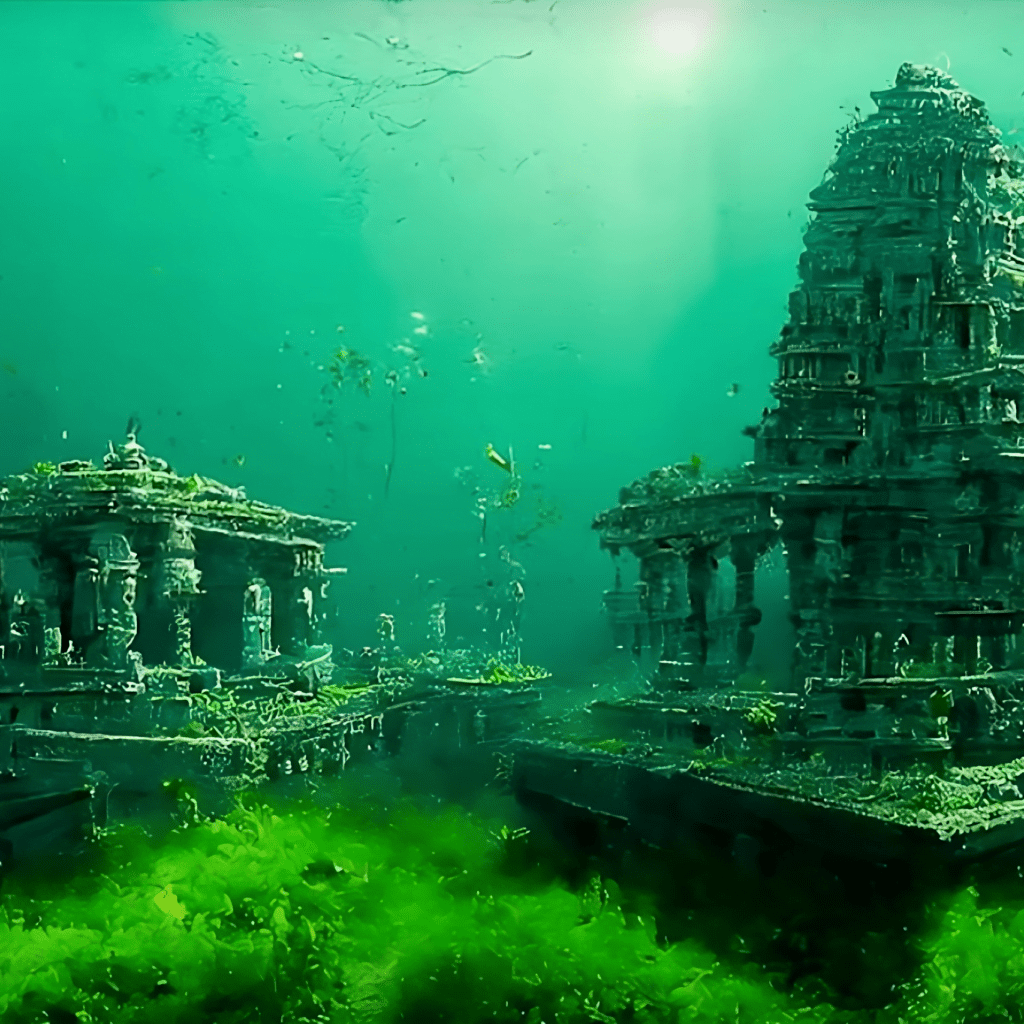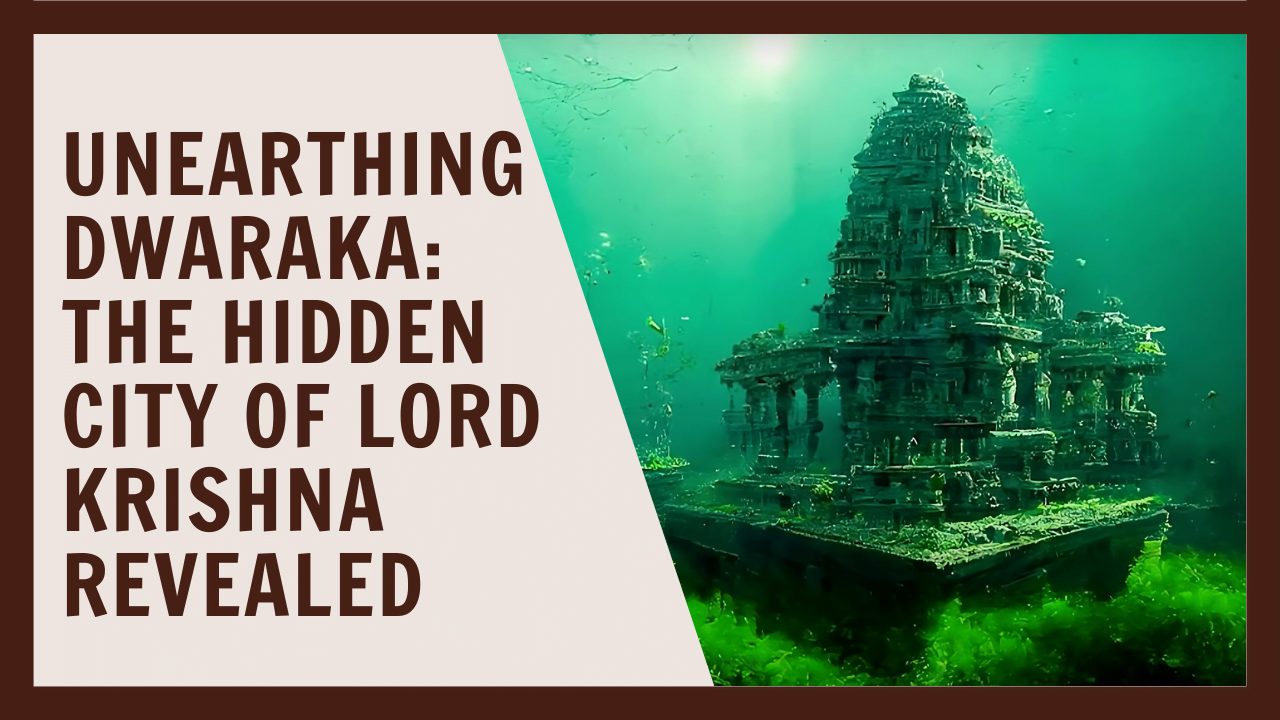Table of Contents
Introduction:
It’s not just mythology; there’s a vast difference between mythology and history. Few decades ago, Indian archaeologists made an astounding discovery – a submerged city at the exact location where the legendary city of Dwaraka, as described in the Mahabharata, is said to have existed. This discovery challenges the common perception that Dwaraka is merely a myth. However, there are misconceptions and misinformation circulating about Dwaraka, particularly regarding a supposed Krishna statue and palace. In this blog post, we will delve into the fascinating archaeological findings and the efforts to establish Dwaraka’s historical significance.

Dwaraka: A Legendary City:
Dwaraka, as described in the Mahabharata, was a fortified city covering an area of 84 kilometres. Situated at the confluence of the Gomati River and the Arabian Sea, it was believed to have been constructed by Lord Krishna himself. Following Lord Krishna’s passing, this ancient city was said to have been submerged by the sea, witnessed by Arjuna. Even today, Dwaraka remains a prominent pilgrimage site in India, but it’s imperative to recognize its archaeological significance, not just its religious importance.

The Archaeological Quest:
The excavation of Dwaraka is one of the most crucial archaeological endeavours of the 20th century. It aims to bridge the thousand-year historical gap in ancient Indian history, which lies between the decline of the Indus Valley Civilization and the emergence of Buddhism. The first archaeological excavation was conducted by the Deccan College of Pune in 1963. They focused on the exterior walls of the Dwarkadhish Temple, publishing their findings in 1963. This initial excavation provided compelling evidence that the modern Dwaraka is at least 2,000 years old.
Unearthing the Layers of Dwaraka:
The first excavation revealed the antiquity of Dwaraka but posed a challenge regarding its timeline. According to their findings, Dwaraka was built after the Mauryan period, which contradicts its mention in the Mahabharata, believed to have occurred at least 8,000 years ago. However, the archaeologists acknowledged that their conclusions were based on a single excavation, leaving room for the discovery of older evidence. To address this, a new excavation on land near the Dwarkadhish Temple was planned, but it required the removal of modern buildings – no easy feat.

In 1979, after 16 years of planning and preparation, the archaeologists finally had an opportunity to commence the excavation after the demolition of modern structures. During this process, they discovered not only ancient artefacts but a shocking revelation. Underneath a stone platform initially thought to be covering an ordinary land, they unearthed the well-preserved remains of a Vishnu temple dating back to the 9th century. This temple consisted of a garbhagriha (sanctum sanctorum), an assembly hall, and a small porch.
The Revelation of Marine Archaeology:
The significant breakthrough came when they dug even deeper beneath the temple’s foundation. Here, they uncovered another older temple and beneath that, a third temple. This progression hinted at the presence of multiple ancient layers, each representing a different era. Astonishingly, they discovered a huge rectangular stone structure that was initially thought to be a well but later identified as a secret passage mentioned in the Puranas. This passage connected the Kushasthali Mahadev Temple with the Dwarkadhish Temple.
Treasures from the Ocean’s Depths:
But the quest to unveil the hidden layers of Dwaraka didn’t stop at the land-based excavation. To validate the city’s ancient origins, marine archaeology was the next frontier. This was a pioneering endeavour, given the lack of experience, equipment, and funding in India’s marine archaeology at the time. Twelve marine excavations were carried out in and around Dwaraka between 1983 and 1992. Among the many discoveries were seal wall structures, iron objects, brass artefacts, pottery, stone objects, and particularly intriguing triangular-shaped three-hole anchors, which were of great significance.
The marine excavations revealed that Dwaraka was not just a single town but an extensive city-state, consisting of several towns and a substantial port. This port was a hub for trade, further confirming the city’s historical significance and corroborating the descriptions found in ancient texts.

Comparing the evidence from these excavations with the writings of the Mahabharata and other Puranas, archaeologists have made an astonishing connection. The location and physical features of the submerged Dwaraka match the descriptions found in these ancient texts with remarkable precision. Furthermore, the evidence supports the notion that Dwaraka was a highly civilised city with advanced engineering, technology, and literacy, in line with the descriptions of a vibrant, thriving city in the Mahabharata and other ancient texts.
The Forgotten History of Dwaraka:
Despite these groundbreaking findings, it’s disheartening that many people are still unaware of the historical significance of Dwaraka. This remarkable discovery provides compelling evidence that Dwaraka, the city built by Lord Krishna, indeed existed just as described in the Mahabharata and other texts. The city is not a mere myth but a historical reality.

Conclusion:
Dwaraka’s history is a treasure trove of India’s ancient past, and it’s essential that we recognize and appreciate its significance. The archaeologists’ relentless efforts have revealed the rich tapestry of our heritage, challenging the notion that this magnificent city is nothing more than a legend. It is high time we reclaim our lost identity and celebrate this remarkable chapter in India’s history. The submerged city of Dwaraka is a testament to the rich cultural and historical heritage of India, waiting to be explored and appreciated.
FAQS
What year was the ancient city of Dwaraka discovered?
The ancient city of Dwaraka was first discovered in 1963 during excavations by Deccan College archaeologists. Further excavations in 1979-1992 revealed more layers.
Where is Dwaraka located in India?
The ancient city of Dwaraka is located on the western coast of India in the state of Gujarat. It lies in the Gulf of Kutch.
How old is Dwaraka as per archaeological evidence?
Based on archaeological excavations and analysis, experts date the origins of Dwaraka to around 3,500 years ago. It was a bustling port city during its peak.
What made the excavation of Dwaraka challenging?
The excavation of Dwaraka was challenging as the ancient city was submerged under the sea. Marine archaeology techniques had to be pioneered in India for the underwater excavations.
What major discoveries were made in Dwaraka?
Some major discoveries in Dwaraka include multiple temple layers, fortified walls, a secret passage, seals, anchors, and many artifacts providing clues about its advanced civilization.
Discover Life’s Answers in the Ancient Teachings of the Bhagavad Gita
Navigate obstacles, find purpose and attain inner peace with the profound wisdom of this ancient Hindu text. Learn how its practical philosophy can transform your life. Click here to unlock the Gita’s timeless lessons.





